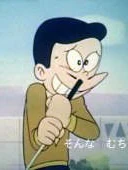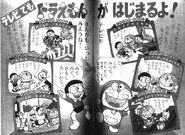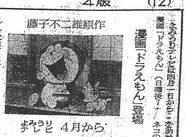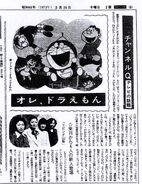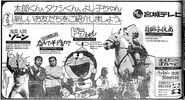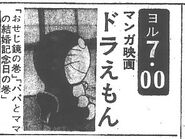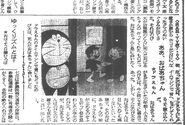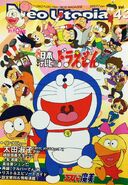For other uses of Doraemon, see the disambiguation page.
The 1973 Doraemon anime series was a brief but successful attempt at adapting the original manga series into anime. It was initially aired on the Nippon TV network starting in April 1973, and lasted 6 months and ended with an episode named "Goodbye, Doraemon". After it ended, Doraemon remained exclusively as a manga until 1979 when TV Asahi produced and aired a second anime adaptation, which finished its run in March of 2005. After the 1979 anime finished its run, a new version of the anime aired shortly after, which is still running to this day.
The series' episodes (approximately 10 minutes long) aired every Sunday from 7:00 PM to 7:30 PM, having two segments (episodes) in each broadcast. It had reruns from 1974 to 1979. The last rerun, in 1979, was ended abruptly after Shogakukan sent a letter to the TV station (Toyama TV) that was airing the series ordering them to stop airing the 1973 series since it would "damage the reputation of the new anime" or "confuse the children".
It is worth noting that the character designs in this anime adaptation appear more stylized than the character designs used in the TV Asahi anime adaption, which were more true to the original manga. It also used a different opening theme, which was possibly influenced partly by the theme song to the original The Pink Panther cartoons.
Characters
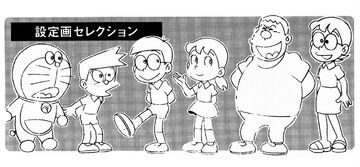
The five main characters and Nobita's mother.
From left to right: Doraemon, Suneo, Nobita, Shizuka, Gian and Tamako.
Main Characters
Other Characters
Episodes list
- Main article: List of Doraemon (1973 anime) episodes
Cancellation
Contrary to popular belief, the series did have good ratings, although it was still considered unsuccessful. It was considered to be renewed for another year, but ultimately was not. It was mainly canceled due to financial issues with Nippon TV Video, as well as the president of the animation studio resigning. The new elected president of the animation studio did not have any interest in continuing the anime.
Rarity
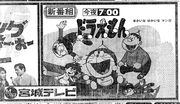
One of the promos for the show.
It is very difficult to find any footage of this version of Doraemon, aside from a few short clips and the opening and ending theme. Nippon TV Video sold off the film reels to attempt to cover their debt. It was also rumored that Nippon TV Video deliberately ordered a "cremation fire" and destroyed all of the episodes. Masami Jun, the production chief of the 1973 series, later confirmed that this was nothing more than a farce.
In 1995, episodes eighteen, and twenty through twenty-six were found to be stored in Studio Rush (now known as IMAGICA) completely intact but with only two episodes without audio. These episodes are commonly shown at Doraemon conventions, but can not be legally released on DVD, due to Nippon TV Video being defunct.
Cast
| Voice Actor | Role(s) |
|---|
Promos of the show
Differences between manga and subsequent anime series
This series had a total of 12 major changes from the original manga.
- Gian lives with his widowed father, who is weaker and shorter and often bullied by Gian himself. In the manga and subsequent anime series, Gian's mother is a recurring character.
- The series ends with Doraemon leaving Nobita permanently, and the former never comes back to the latter. There was going to be a second season in which Doraemon returns from the future, but due to its cancellation, it never happened.
- The Take-copter is named "Heritonbo", name used in the early manga.
- Doraemon comes from the 21st century, instead of the 22nd century.
- Sensei has a given name, Ganari (???).
- There was an additional character named Gachako, an annoying female robot duck. She was removed from later versions of the manga and never appeared in the subsequent anime series as Fujiko F. Fujio disliked her.
- Dorami, Dekisugi and Jaiko never appeared. The latter is often mistaken with Botako by their appearance.
- The series emphasized slapstick comedy.
- Nobita's school was named "Downtown Elementary School".
- Doraemon's gadgets were called "Secret Weapons".
- Sewashi, like Nobita, had glasses.
- Botako is a recurring character and Shizuka's housekeeper.











